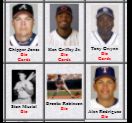1985 Topps #401 Mark McGwire ROOKIE USA OLYMPIC TEAM [#a]
McGwire is pictured in his 1984 U.S.A. Olympics jersey. His first card in a major league uniform was 2 years later.![1985 Topps #401 Mark McGwire ROOKIE USA OLYMPIC TEAM [#a] cards value](/jpgs/8/1985-401.jpg)

Please wander around the website for more info, prices, values & images
on vintage baseball, football, basketball, hockey, sport and non-sports cards.


1981 Fleer Baseball
Collector's were excited when they heard Fleer was re-entering the
baseball card market. Their prior issues, the 1959 Fleer Ted Williams
set and their 1963 Fleer baseball-Star sets were hgue succeses.
What did they have up their sleeve ???
Other issues you may be interested in: The answer was NOTHING ! What a mess. Awful ! Poorly printed on medicore card stock, the images were even worse. Then to cap it off, Fleer introduced tons of errors into their set. Some think it was done on purpose to force collector's to keep collecting. Nearly all were useless. The only one to draw much attention was the Graig Nettles variations. One had his name spelled Craig on back. WOW !!!
TOP ROOKIES: Hall-of-Famers Tim Raines and Harold Baines. Oother rookies of note were Danny Ainge, later a pro with the Boston Celtics and World Series hero Kirk Gibson. 1963 Fleer Baseball 1981 Fleer Baseball (You may be on that page now) 1982 Fleer Baseball |

Tony Gwynn, Padres Right -Fielder
|

Starting approximately in 1886, sportscards, mostly baseball cards, were often included with tobacco products, for promotional purposes and also because the card reinforced the packaging and protected cigarettes from damage. These sports cards are referred to as tobacco cards in the baseball card hobby. Over the next few years many different companies produced baseball cards. Tobacco cards soon started to disappear as the American Tobacco Company tried to develop a monopoly by buying out other companies.
They were reintroduced in the 1900s, as American Tobacco came under pressure from antitrust action and Turkish competition. The most famous and most expensive, baseball card is the rare T206 Honus Wagner. The card exists in very limited quantities compared to others of its type because Wagner forced the card to be removed from printing. It is widely (and incorrectly) believed that Wagner did so because he refused to promote tobacco, but the true explanation lies in a dispute over compensation.
Soon other companies also began producing baseball and football cards. Sports magazines such as The Sporting News were early entries to the market. Candy manufacturers soon joined the fray and reflected a shift toward a younger target audience for cards. Caramel companies were particularly active and baseball cards were one of the first prizes to be included in Cracker Jacks. World War I soon suppressed baseball card production.
 Click here to view other players
Click here to view other players
